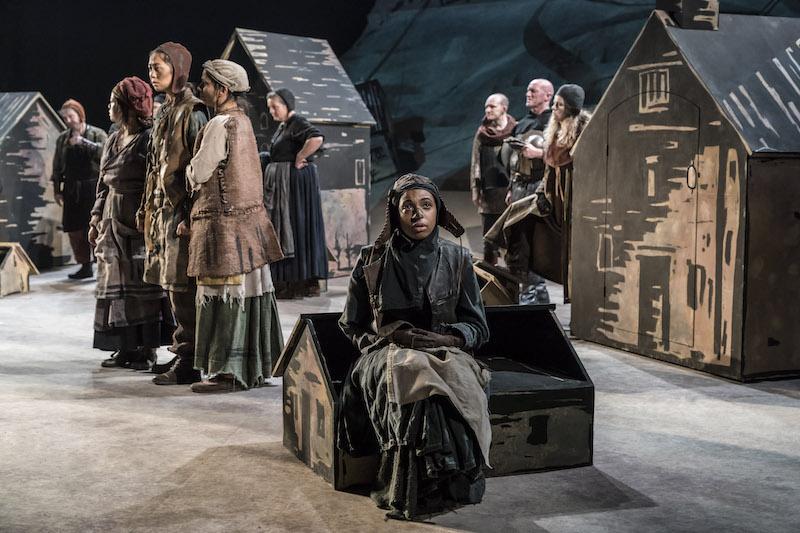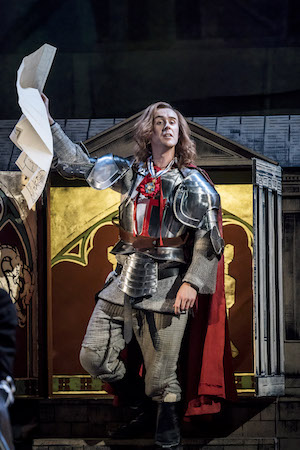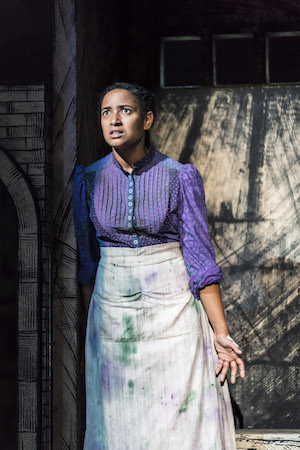Saint George and the Dragon, National Theatre review – a modern folk tale in the Olivier | reviews, news & interviews
Saint George and the Dragon, National Theatre review – a modern folk tale in the Olivier
Saint George and the Dragon, National Theatre review – a modern folk tale in the Olivier
England’s patron saint travels through time to demonstrate changing views of heroism

Bold and fearless are adjectives that might describe playwright Rory Mullarkey as accurately as any chivalrous knight. He made his name in 2013 when, at the age of 25, his play Cannibals, part of which was in Russian, took to the main stage at the Manchester Royal Exchange and went on to win the James Tait Black Prize.
 Saint George and the Dragon comes, in proper folk fashion, in three distinct parts. The first act might be mistaken for the National’s Christmas show. All the familiar fairy tale ingredients are there: a wandering knight who prizes liberty undertakes to rescue a maiden about to be eaten by a fire-breathing dragon. He is the underdog, but bravery and honesty prevail, he wins the lady and receives gratitude and adulation from the villagers relieved of their tyrant. But this knight began as a coward – having first failed to kill a different dragon, he fled. In John Heffernan’s engaging performance (pictured left) he is open-faced and innocent to the point of naiveté, while Elsa, his lady (Amaka Okafor, pictured below right), with plenty to say for herself, is no soppy maiden. There is a witty light heartedness about the whole thing: the intended victim complains about having to wear herbs in her hair in preparation for being eaten, and the dragon, taking human form for convenience, is camp in ’tache and diadem.
Saint George and the Dragon comes, in proper folk fashion, in three distinct parts. The first act might be mistaken for the National’s Christmas show. All the familiar fairy tale ingredients are there: a wandering knight who prizes liberty undertakes to rescue a maiden about to be eaten by a fire-breathing dragon. He is the underdog, but bravery and honesty prevail, he wins the lady and receives gratitude and adulation from the villagers relieved of their tyrant. But this knight began as a coward – having first failed to kill a different dragon, he fled. In John Heffernan’s engaging performance (pictured left) he is open-faced and innocent to the point of naiveté, while Elsa, his lady (Amaka Okafor, pictured below right), with plenty to say for herself, is no soppy maiden. There is a witty light heartedness about the whole thing: the intended victim complains about having to wear herbs in her hair in preparation for being eaten, and the dragon, taking human form for convenience, is camp in ’tache and diadem.
Director Lyndsey Turner (a previous Mullarkey collaborator) stages the duel brilliantly mainly by making the audience imagine it is happening in the sky out of sight. Two of the dragon’s three heads make spectacular stage-fall from above, however, and George reappears bloody and triumphant. The red-on-white English flag is formed by blood stains making a cross shape between the cake tins of the hero’s makeshift armour.
 Nothing is as much fun in the two remaining acts.
Nothing is as much fun in the two remaining acts.
The villagers take George’s advice to dream of their future while he disappears, summoned by the mysterious Brotherhood of Knights to kill more dragons. He returns after a year, but the changes of many generations have occurred in his absence and industrialisation has gripped the land. The dragon is now a vicious factory owner, standing for Victorian capitalism, and Elsa is to be hanged for stopping the machinery when a child worker is injured. She is rescued and George is again summoned while the villagers dream. He returns to a dystopian vision of modern Britain (or “an island much like our own") with its soulless tower blocks and street violence. The dragon is still lurking, but he claims that, being now part of all of us, he can no longer be so summarily killed. Is there any longer a place for heroes? Does Elsa – or anyone – need to be rescued or should we all take responsibility for ourselves? Is there any point in dreaming of the future? The ending is a long way from that breezy beginning.
Fluent Russian speaker Mullarkey has taken his cue from Evgeny Schwartz’s 1943 play The Dragon, an allegorical critique of Stalinism. Our muddling, faltering democracy lends itself less readily to similar treatment and there is a danger that we end up simply dispirited about the present, imagining some golden past. Hasn’t the dragon – and the hero – always been a part of us all?
The scope of the piece is daring and it is beautifully designed by Rae Smith whose medieval village of three-dimensional sketched houses becomes a land of factories and then of brutalist blocks. Mullarkey is undoubtedly talented, dealing in ideas and employing language with a confident flourish, but here the result is not equal to the ambition.
rating
Explore topics
Share this article
The future of Arts Journalism
You can stop theartsdesk.com closing!
We urgently need financing to survive. Our fundraising drive has thus far raised £33,000 but we need to reach £100,000 or we will be forced to close. Please contribute here: https://gofund.me/c3f6033d
And if you can forward this information to anyone who might assist, we’d be grateful.

Subscribe to theartsdesk.com
Thank you for continuing to read our work on theartsdesk.com. For unlimited access to every article in its entirety, including our archive of more than 15,000 pieces, we're asking for £5 per month or £40 per year. We feel it's a very good deal, and hope you do too.
To take a subscription now simply click here.
And if you're looking for that extra gift for a friend or family member, why not treat them to a theartsdesk.com gift subscription?
more Theatre
 Fiddler on the Roof, Barbican review - lean, muscular delivery ensures that every emotion rings true
This transfer from Regent's Park Open Air Theatre sustains its magic
Fiddler on the Roof, Barbican review - lean, muscular delivery ensures that every emotion rings true
This transfer from Regent's Park Open Air Theatre sustains its magic
 In Praise of Love, Orange Tree Theatre review - subdued production of Rattigan's study of loving concealment
Unspoken emotion flows through this late work
In Praise of Love, Orange Tree Theatre review - subdued production of Rattigan's study of loving concealment
Unspoken emotion flows through this late work
 Letters from Max, Hampstead Theatre review - inventively staged tale of two friends fighting loss with poetry
Sarah Ruhl turns her bond with a student into a lesson in how to love
Letters from Max, Hampstead Theatre review - inventively staged tale of two friends fighting loss with poetry
Sarah Ruhl turns her bond with a student into a lesson in how to love
 Elephant, Menier Chocolate Factory review - subtle, humorous exploration of racial identity and music
Story of self-discovery through playing the piano resounds in Anoushka Lucas's solo show
Elephant, Menier Chocolate Factory review - subtle, humorous exploration of racial identity and music
Story of self-discovery through playing the piano resounds in Anoushka Lucas's solo show
 This is My Family, Southwark Playhouse - London debut of 2013 Sheffield hit is feeling its age
Relatable or stereotyped - that's for you to decide
This is My Family, Southwark Playhouse - London debut of 2013 Sheffield hit is feeling its age
Relatable or stereotyped - that's for you to decide
 The Frogs, Southwark Playhouse review - great songs save updated Aristophanes comedy
Tone never settles, but Sondheim's genius carries the day
The Frogs, Southwark Playhouse review - great songs save updated Aristophanes comedy
Tone never settles, but Sondheim's genius carries the day
 Mrs Warren's Profession, Garrick Theatre review - mother-daughter showdown keeps it in the family
Shaw's once-shocking play pairs Imelda Staunton with her real-life daughter
Mrs Warren's Profession, Garrick Theatre review - mother-daughter showdown keeps it in the family
Shaw's once-shocking play pairs Imelda Staunton with her real-life daughter
 The Crucible, Shakespeare's Globe review - stirring account of paranoia and prejudice
Ince's fidelity to the language allows every nuance to be exposed
The Crucible, Shakespeare's Globe review - stirring account of paranoia and prejudice
Ince's fidelity to the language allows every nuance to be exposed
 The Fifth Step, Soho Place review - wickedly funny two-hander about defeating alcoholism
David Ireland pits a sober AA sponsor against a livewire drinker, with engaging results
The Fifth Step, Soho Place review - wickedly funny two-hander about defeating alcoholism
David Ireland pits a sober AA sponsor against a livewire drinker, with engaging results
 The Deep Blue Sea, Theatre Royal Haymarket review - Tamsin Greig honours Terence Rattigan
The 1952 classic lives to see another day in notably name-heavy revival
The Deep Blue Sea, Theatre Royal Haymarket review - Tamsin Greig honours Terence Rattigan
The 1952 classic lives to see another day in notably name-heavy revival
 The Brightening Air, Old Vic review - Chekhov jostles Conor McPherson in writer-director's latest
The Irishman's first new play in over a decade is engaging but overstuffed
The Brightening Air, Old Vic review - Chekhov jostles Conor McPherson in writer-director's latest
The Irishman's first new play in over a decade is engaging but overstuffed
 1536, Almeida Theatre review - fast and furious portrayal of women in Henry VIII's England
This wild, intelligent play is a tour de force till the doom-laden finale
1536, Almeida Theatre review - fast and furious portrayal of women in Henry VIII's England
This wild, intelligent play is a tour de force till the doom-laden finale

Add comment